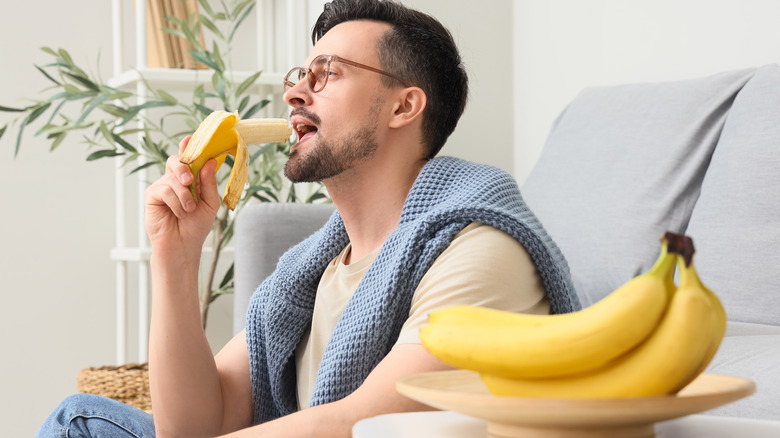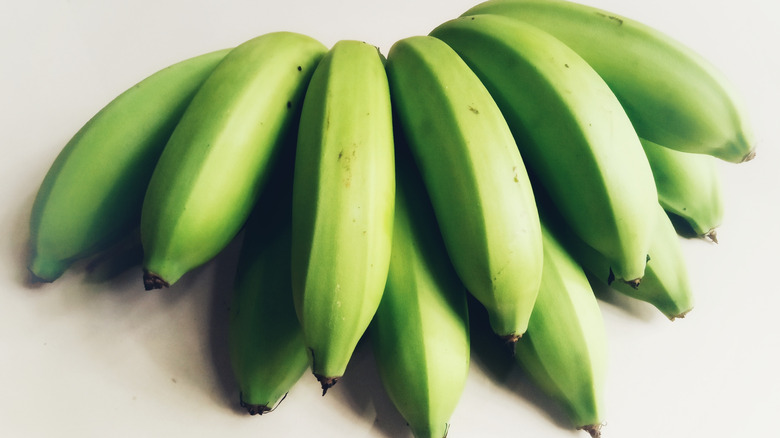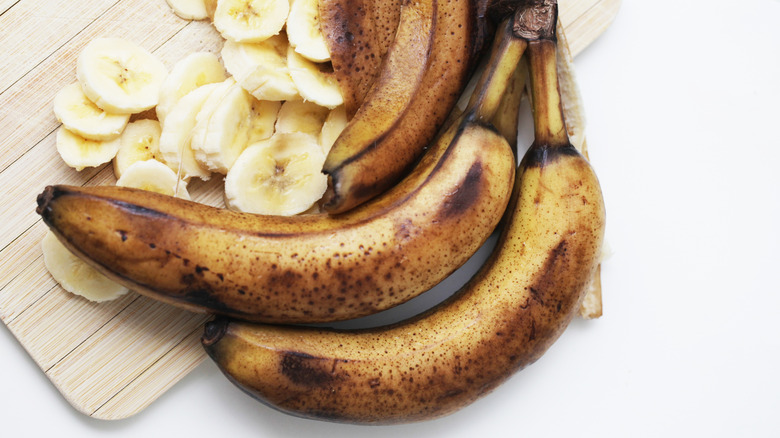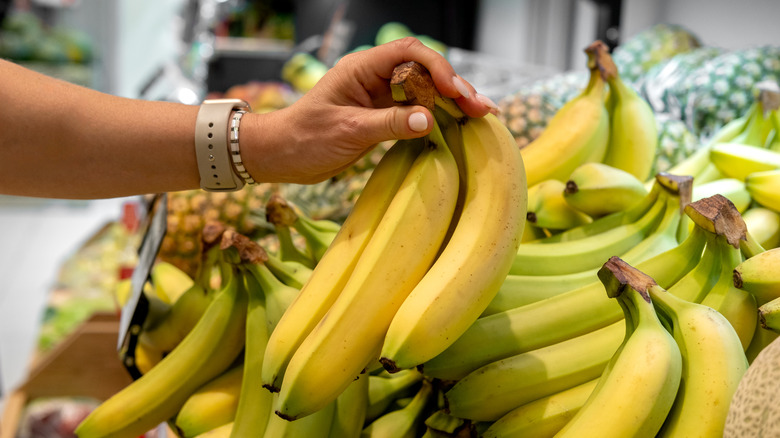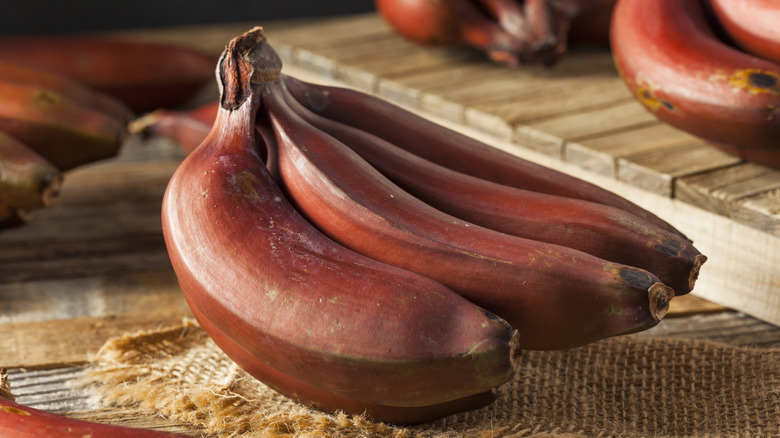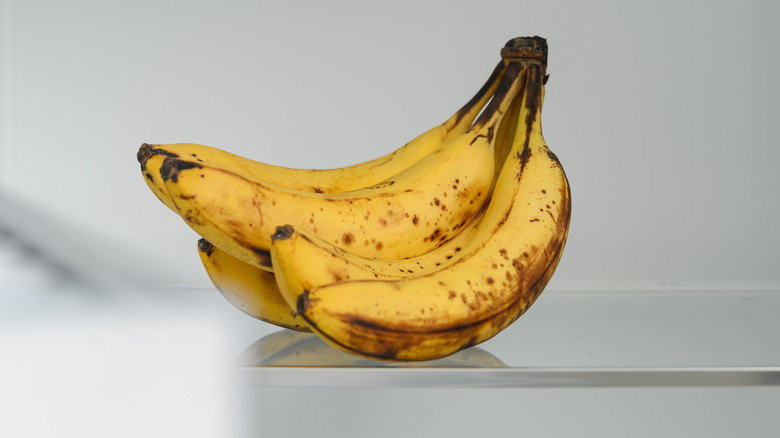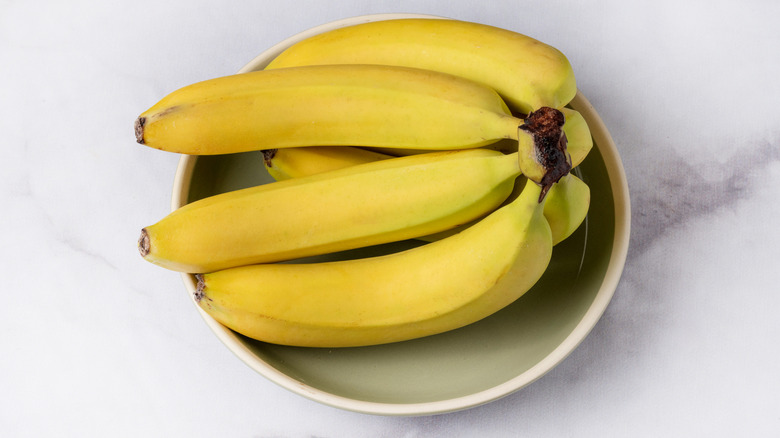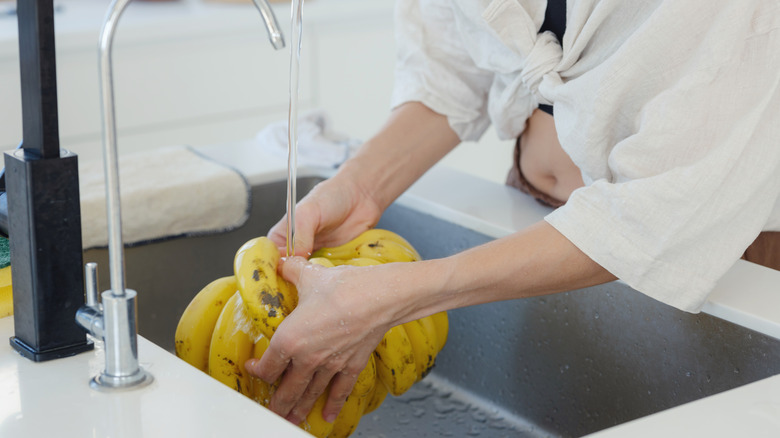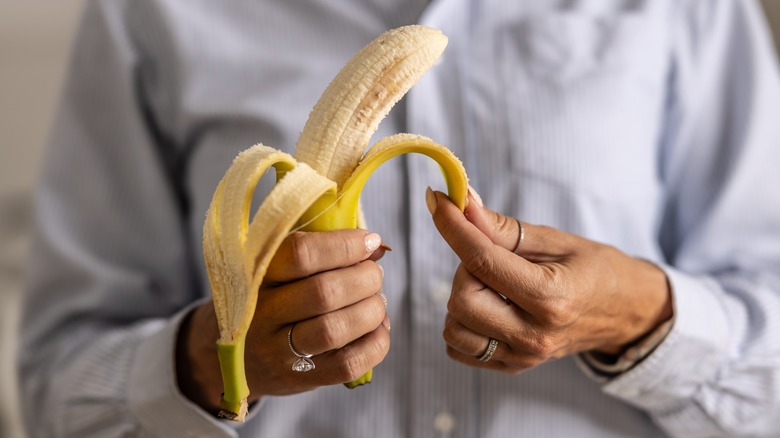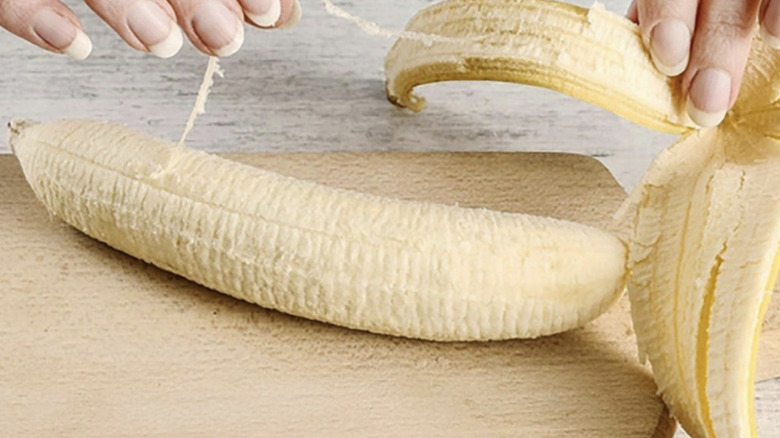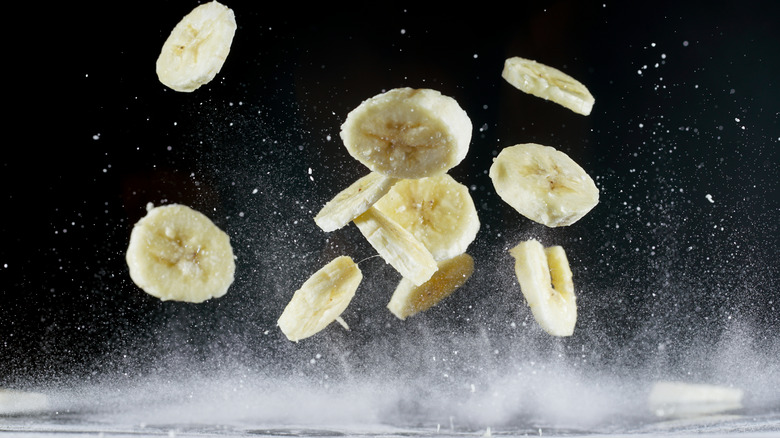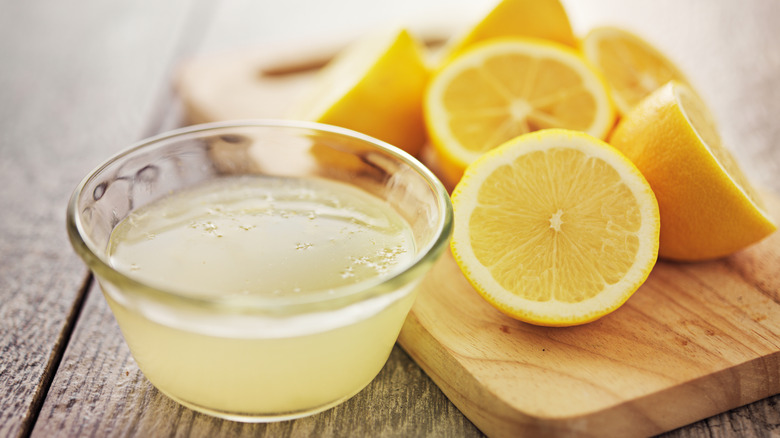12 Mistakes People Make With Bananas
We may receive a commission on purchases made from links.
The sweet flavor and creamy texture of bananas are hard to resist. A perfect peel-and-eat snack, bananas are also extremely versatile and widely available, making them a staple in kitchens around the world. Aside from making a great on-the-go bite, the yellow fruit tastes delicious blended into smoothies and shines as a topping for oatmeal, cereal, or yogurt. Ripe bananas are also often used in baking, adding both natural sweetness and moisture to recipes like banana upside-down cake or bread and muffins. Best of all, bananas are a healthy food choice — they are loaded with dietary fiber, potassium, antioxidants, and vitamin C.
Despite being such a common grocery item, however, bananas are often misunderstood. Many shoppers fail to appreciate how drastically the fruit's flavor and culinary use can change depending on their ripeness level. On top of this, people often store the yellow fruit incorrectly, either impeding the ripening process or accelerating spoilage.
Are you keen to find out more about the most common mistakes consumers make with bananas and how to avoid them? You are in the right place. Let's dive in!
Selecting bananas that are too green for immediate use
Many bananas sold in grocery stores are still green. And this in itself isn't a bad thing. In fact, it's a common practice. Bananas are typically harvested while they are green to ensure that they don't ripen too fast — and spoil — during transportation and storage. This, however, doesn't mean that green bananas are ideal for snacking and cooking.
As with many other fruits, the ripeness of bananas can usually be judged by their color. Bananas that are green are usually under-ripe, which means that they are too bitter in flavor for many palates. Green bananas also have a firmer texture than their ripe counterparts, making them harder to peel. While they may not make the ideal snack, green bananas are just as nutritious as yellow bananas, and in some respects even more so. Green bananas are high in resistant starch and pectin, which can regulate blood sugar levels and aid digestive health.
When buying unripe bananas, it's important to inspect their stems. If the stems are firm and green, the bananas are likely to ripen without any issues. On the other hand, bananas with brown stems may already be older and not have ripened properly. Similarly, damaged stems can result in uneven ripening, as this can affect the fruit's normal production of ethylene, which is a gaseous hormone responsible for ripening.
Purchasing bananas that are overly ripe
Just as underripe bananas can be too tough and bitter, overripe bananas might be too mushy and sweet for some tastes. This is why it's best to buy either yellow bananas that are ready to eat or green bananas that can ripen on your kitchen countertop. Bananas ripen over time because their starch turns into sugar, which makes them both softer and sweeter. While this is considered desirable by most people, pushing bananas past their peak can leave you with fruit that may only be suitable for baking or the compost bin.
While overly ripe bananas — even the ones that have completely black skin — are usually safe to eat, it's probably best not to risk it. The darker and mushier the banana, the more likely it is to harbor bacteria, some of which can make you sick. While overly ripe bananas can normally still be used in cooking, since heat kills bacteria, there are certain signs that indicate that the fruit has gone bad and it's time to toss it. Some of these include mold or blackened banana flesh. In addition, a rotten or fermented smell or oozing bananas are no longer safe to eat.
Failing to inspect the bananas before buying them
While green bananas typically need a little patience, overly ripe bananas may be best suited for banana muffins, or in the most extreme cases, the trash can. This raises the question — what should a shopper look for when choosing the perfect ready-to-eat bananas? Luckily, selecting a perfectly ripe banana doesn't require expert knowledge. Most of the time, all that's required is a simple check of the fruit's color and a quick squeeze.
Ideally, bananas that are ready to eat should have yellow, unblemished skin or just a few brown spots. It's best to avoid overly green or brown bananas. Buying bananas with a bruised peel is a big no-no. Visible bruises are typically a sign of internal damage caused by mishandling during transportation and storage. In addition, ripe bananas should yield gently to pressure rather than being overly firm or mushy. In terms of smell, ripe bananas normally have a sweet, mildly floral scent. Bananas that lack smell altogether are probably underripe, while fruit with a sour odor likely means that it has seen better days.
One of the biggest mistakes when banana shopping is overlooking fruit with damaged stems or necks. Any tears or cracks in that area leave the fruit vulnerable to oxidation, bacteria, and general spoilage. According to the USDA, once banana flesh is exposed to air, the fruit shouldn't be left out at room temperature for longer than two hours.
Overlooking the different types of bananas
For U.S. shoppers, it's easy to assume that most bananas look and taste the same. This is because the Cavendish banana makes up the bulk of what is sold in U.S. grocery stores. In fact, the Cavendish banana represents almost half of the global banana market, with around 50 billion tons of the fruit produced each year. Sweet and mildly fruity in flavor, the Cavendish is both a great snack and cooking ingredient. But interestingly, the Cavendish wasn't always the banana of choice in the U.S.
Historically, the banana industry favored the Gros Michel, a sweet, creamy, and resilient banana that did very well during transport. After the Gros Michel banana was wiped out by a fungal infection called Panama Disease, the United Fruit Company, which controlled the banana industry in the region at the time, simply swapped it for the Cavendish.
Considering the limited selection of bananas in the U.S., it may come as a surprise that there are over 1,000 different varieties of the fruit around the world. These include starchy and mildly sweet plantains, small and honey-like lady fingers, and red bananas, which are very similar in taste and texture to the Cavendish.
Putting bananas in the refrigerator
When bananas are on special — or you simply buy more than you can consume before they spoil – placing them in the refrigerator might seem like a smart move. In reality, this can work — provided that you know what you are doing. After all, there is a good reason why supermarkets don't refrigerate the yellow fruit.
If the bananas are still green, sticking them in the fridge will stop or slow down the ripening process. On top of that, the cold temperature will gradually turn the fruit's peel completely black. In a pinch, you can get away with storing ripe bananas in the fridge for a day or two. That said, always check for mold or an off smell before eating them.
Instead of refrigerating bananas, keep the fruit fresh longer by storing them in a cool, dark place. Sunlight speeds up ripening, so keeping bananas out of direct light helps. The ideal storage temperature for bananas hovers around 60 degrees Fahrenheit, which is approximately room temperature. Anything below 55.4 degrees Fahrenheit can lead to chilling injury, leaving the fruit with a bitter taste.
Not understanding that storing bananas in a bag accelerates ripening
Along with fruits like avocados, peaches, and mangoes, bananas produce ethylene, a naturally occurring hormone that plays an important role in the ripening process. While ethylene is beneficial if you want your fruit to ripen faster, it's counterproductive to extending its shelf life.
To turn green bananas yellow faster, place them in a paper bag to concentrate their ethylene. You can even place the bananas in an enclosed space with other ethylene-producing fruits to speed up the process. If possible, try to avoid storing bananas in a plastic bag, as this causes moisture build-up and can lead to spoilage. Conversely, never store bananas in a bag if you are trying to prolong their shelf-life. Instead, wrap the banana stems in plastic wrap or aluminum foil, as the stems release the most ethylene.
Interestingly, you can buy banana storage bags that claim to extend fruit freshness by creating an environment that slows the ripening process. However, the reviews about the product have been mixed. On the positive side, one Amazon shopper has called the product a "game changer," saying, "Even though the outside peel gets brown, the inside is pristine!" On the other end of the spectrum, another Amazon reviewer claims that the product actually "makes your bananas go bad much faster."
Forgetting to rinse the bananas before eating them
Rinsing is an obvious step when it comes to fruits eaten with their skins, such as pears and apples. After all, no one wants to consume dirt or pesticide residue along with the fruit. However, the importance of rinsing isn't as clear when it comes to produce with inedible peels like avocados, melons, and bananas.
Despite being peeled before consumption, bananas should always be washed under running water before eating. There are a few reasons for this. Fruit flies could lay eggs on the banana peel, leading to a full-blown infestation in your kitchen — this is why it's best to wash them as soon as you get home. Washing bananas also helps reduce bacteria and foodborne pathogens like listeria. Even if you are not using a knife to slice the banana, the bacteria can be transferred to the fruit's flesh during peeling.
While the USDA recommends rinsing all produce, it advises consumers to stay away from detergent or soap, as any product residue left on the fruit can lead to potential health issues. For best results, rinse bananas under running water for about 30 seconds and wipe them dry with a clean towel.
Peeling the bananas from the stem end
While this may come as a surprise to many, the classic way of peeling bananas from the stem end isn't the most effective way of starting your banana-eating experience. Instead, many recommend peeling bananas from the tip, which is the way monkeys have been doing it for as long as they have been eating the yellow fruit. To clarify, the banana stem is the side that connects the fruit to the bunch and the smaller, rounded end on the opposite side is the tip.
Starting the peeling process from the rounded end of the banana is easy — you simply pinch the tip and watch the banana peel split in two. This means that it's less likely to make the fruit mushy than peeling it from the stem, especially if the banana is very ripe. It also keeps those pesky white strands attached to the peel, which is ideal for those who don't like eating them.
Lastly, peeling bananas from the tip will leave you with an intact stem, providing a convenient handle. Those who insist on peeling their bananas from the stem can make the process easier by making a small cut where the stem joins the inside curve of the banana.
Throwing out overripe bananas
Whether you have bought too many bananas at once or haven't stored them properly, ending up with overripe fruit is a common problem. However, rather than throwing them away, you can easily give them a second life. Ripe bananas make a great addition to smoothies and recipes.
Perhaps one of the most popular uses for ripe bananas is banana bread. While bright yellow bananas are likely to work in a pinch, it's the ripe bananas with black spots that yield the best banana bread. This is because yellow bananas are only mildly sweet. Ripe bananas, on the other hand, have broken down much of their starch into sugar, resulting in a softer texture and a deeper, more concentrated flavor. Best of all, you can make banana bread with just three ingredients – simply combine bananas, eggs, and boxed yellow cake mix and bake until golden.
Ripe bananas can also add sweetness and character to other more out-of-the-box dishes. For instance, the fruit shines in desserts like banana cream pudding eclairs, where it is diced and folded into vanilla custard. Alternatively, the sweetness of ripe bananas can elevate the flavor of four-ingredient frozen fudge. Notably, bananas can also enhance more savory dishes, adding a touch of sweetness to recipes like banana-chicken casserole.
Not eating those white banana strings
The stringy bits inside the banana peel can be annoying, but unless you find them particularly bothersome or unappealing, it's best to leave them in place. As it turns out, they are both edible and functional. Officially called "phloem bundles," the fibrous strings play an important role in fruit development — let's just say that without them, bananas wouldn't develop properly. This is because as the banana grows, the little tubes transfer vital nutrients throughout the fruit, providing it with sustenance.
Phloem bundles are not only edible but also very nutritious. Just like other parts of the banana — including the peel — they are rich in fiber, potassium, vitamin A, and vitamin B6. Interestingly, the white strings can offer important clues about a banana's ripeness. Phloem bundles that stick firmly to the fruit's flesh typically indicate an unripe banana, whereas those that peel away easily indicate that the banana is ripe and ready to enjoy.
Not freezing ripe bananas properly
If you know you won't be able to eat your ripe bananas before they spoil or don't have the time to incorporate them into a recipe, freezing is always preferable to tossing them out — as long as you follow a few simple guidelines. It's best not to freeze unpeeled bananas, as the skin can be tricky to remove once they are frozen. As such, always peel the fruits before popping them in the freezer.
Whether freezing whole or sliced bananas, it's a good idea to space them out on a tray before putting them in the freezer. Once frozen, simply transfer them to a freezer bag. This way the fruit pieces won't clump together. When freezing overripe bananas, mash them and portion them out in bags. No matter how you prepare them, frozen bananas will keep well for around six months.
Aside from preservation, freezing bananas has quite a few benefits. Tossing bananas in the freezer makes them both sweeter and creamier due to the starch breakdown triggered during the freezing process. This makes frozen bananas ideal for snacking and use in recipes. Frozen bananas also make a delicious base for toppings such as chocolate, Greek yogurt, or chia seeds.
Not preserving peeled bananas with acidic solution
Many of us have been there – pre-slicing bananas for a fruit salad, only to find that they have turned brown by the time guests arrive. This unappetizing browning is the result of oxidation, a process that occurs when the fruit is exposed to air. Once you peel a banana and slice it, the enzymes in the fruit react with oxygen, turning it brown. While still edible, these brown slices are probably going to be passed over by guests.
Luckily, there is a very simple solution to this common problem. As with other fruits like avocados and apples, coating freshly-cut banana flesh with a little acidic solution can go a long way toward delaying the browning process. Some of the most commonly used options include lemon juice, lime juice, pineapple juice, orange juice, or even vinegar. For something a little sweeter, you can even dilute honey with a little water and use this mixture as a coating.
